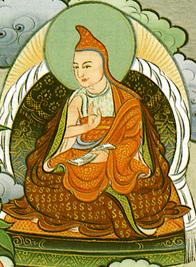Annotated Commentary on the Bodhicharyavatara: Difference between revisions
Jump to navigation
Jump to search
| Line 1: | Line 1: | ||
''' | [[Image:Khenpo Shenga thangka.JPG|frame|'''Khenpo Shenga''']]'''Annotated Commentary on the Bodhicharyavatara''' – ( [[Wyl.]] spyod ‘jug ‘mchan ‘grel), a commentary on the [[Bodhicharyavatara]] written by [[Khenpo Shenga]], based on the oral tradition of [[Patrul Rinpoche]]. | ||
Khenpo Shenga was a student of [[Orgyen Tendzin Norbu]] with whom he studied for thirteen years and from whom he received the oral explanation lineage of Paltrul Rinpoche. Based on these teachings, he wrote his famous ’annotation commentary’ on the ‘thirteen great textbooks’ of Indian origin, including the Bodhicharyavatara. | Khenpo Shenga was a student of [[Orgyen Tendzin Norbu]] with whom he studied for thirteen years and from whom he received the oral explanation lineage of Paltrul Rinpoche. Based on these teachings, he wrote his famous ’annotation commentary’ on the ‘thirteen great textbooks’ of Indian origin, including the Bodhicharyavatara. | ||
Revision as of 07:50, 5 October 2007

Annotated Commentary on the Bodhicharyavatara – ( Wyl. spyod ‘jug ‘mchan ‘grel), a commentary on the Bodhicharyavatara written by Khenpo Shenga, based on the oral tradition of Patrul Rinpoche.
Khenpo Shenga was a student of Orgyen Tendzin Norbu with whom he studied for thirteen years and from whom he received the oral explanation lineage of Paltrul Rinpoche. Based on these teachings, he wrote his famous ’annotation commentary’ on the ‘thirteen great textbooks’ of Indian origin, including the Bodhicharyavatara.
Praise for Khenpo Shenga’s Annotation Commentaries
Kyabje Khenpo Trashi Palden said:
- In general, the ‘teaching tradition’ at our shedra [Trashi Yangzhag Kyilwa] followed the tradition of the Dzongsar Shedra, which in turn was based on Khenpo Shenga’s annotation commentaries to all ‘thirteen great textbooks of Indian origin’. These annotation commentaries, which for the most part are based on the Indian commentaries to these texts, provide the basis for teaching on all the great textbooks of Indian origin. [1]
Khenpo Pema Sherab said:
- The first teachings I received on the Bodhicharyavatara were given by Khenpo Triso Rinchen and were based on Khenpo Shenga’s annotation commentary. From Khenpo Sangye Tendzin I received another commentary on the Bodhicharyavatara, also based on Khenpo Shenga’s annotation commentary. From Dilgo Khyentse Rinpoche, in 1967, I received a reading transmission interspersed with commentary on Khenpo Kunpal’s commentary.
- Khenpo Shenga wrote an ’annotation commentary’ on each of the ‘thirteen great textbooks’ of Indian origin, including the Bodhicharyavatara. One reason that Khenpo Shenga’s annotation commentaries are so widely used is that his lineage of explanation goes back to Paltrül Rinpoche. Paltrül Rinpoche’s lineage carries a lot of blessing and powerful aspirations.
- Khenpo Shenga himself was not biased by any sectarianism, basing his annotation commentaries for the most part on ‘Indian commentaries’. The Indian texts are considered to be without error and are prior to any of the sectarianism of the Tibetan schools. This is another reason why the Nyingma, Sakya and Kagyü schools all accept Khenpo Shenga’s annotation commentaries.[1]